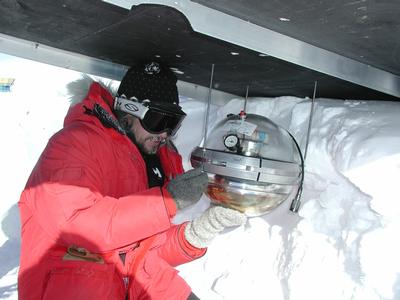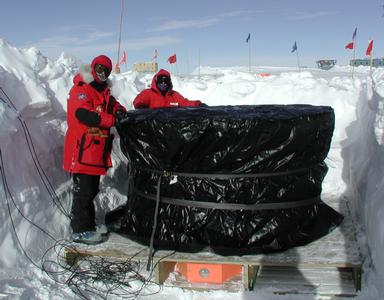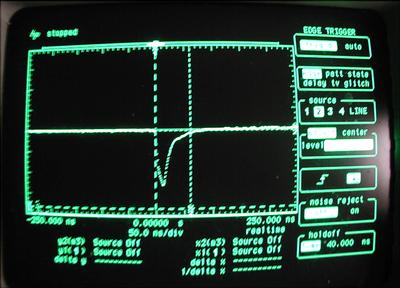1 December, 2001
Each day the sun climbs a little higher in the sky, providing warmer temperatures on the Antarctic Plateau. Taking advantage of the warm weather, we headed out to the the Dark Sector early this morning to continue working on the detector.
Since the optical modules (OMs) each weigh over thirty pounds, we used a sled to transport them to the work site. The two OMs were attached to the lid of the tank and the inside of the tank was lined with a strong white inner liner. We used a white liner so that any light generated by muons would be reflected into the tank and not absorbed by the black colored tank.
Since the original bottom outer liner was destroyed by the frigid temperatures a few days before, we had to improvise a way to make the tank light proof. Using a few roles of felt, we layered the gap between the lid and the tank. Then, to be extra careful, we draped huge layers of additional felt over the tank lid. We added another layer of draping using thick dark plastic sheets. Finally, we covered the entire tank with the black top cover, made from a different material than the useless bottom tank cover.
The OMs were connected with data cables and a high voltage line. We were now ready to return to the SPASE Shack and turn the power on. It took only a few computer commands to run electricity to the new detector to conduct the much anticipated light test. Looking at the instrumentation, we waited patiently to see if any light was leaking into our detector.
If the detector was in fact light tight, then we would see a nice flat line on the computer screen. If light was leaking into the tank, we would see many random spikes in the line. The only deviation that was expected in the line was a periodic pulse, or dip, in the line. We waited...and finally we realized we were successful!
A nice flat line appeared on the computer screen, only to be interrupted by a periodic pulse indicating a passing muon. We recorded a few minutes of the data and sent it to the Bartol Research Institute for confirmation. Once we receive confirmation that we have constructed the detector correctly, we could begin filling the tank with water and initiate the freezing process.
We quickly received word from Bartol that our detector was indeed working properly. We placed our request for the water, taken from the drinking well at the South Pole, to be delivered on Tuesday. The next challange will be to control the freezing of the water in the tank. If it freezes to quickly, the frozen water will be full of bubbles, rendering all of our work and the detector useless.
Biological Data
Saturated Oxygen: 92%
Pulse Rate: 85
Weather Data
Temperature: -28.6 F
Wind Chill: -54.6 F

Jason Petula installing an optical module onto the detector's lid.

The detector completely covered before the light test.

Computer screen showing a pulse generated by a muon from our detector.
Contact the TEA in the field at
.
If you cannot connect through your browser, copy the
TEA's e-mail address in the "To:" line of
your favorite e-mail package.
|
